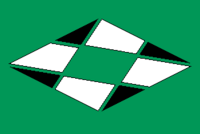Turkestan Rail Network
| Ellik Temir Yolları Örmägi | |
|---|---|

| |
| Type | State Company |
| Slogan | Arğa Çığayıq; (Moving Forward) |
| Founded | 1940s |
| Location | Turkestan-wide, headquarters in Buxara, Üzbekistan |
| Key people | KEY PEOPLE |
| Employees | NUMBER OF EMPLOYEES |
| Industry | Rail Transport |
| Products | Transportation services Rail infrastructure |
| Revenue | REVENUE |
ETYÖ, the Turkestani National Rail Network company, is the umbrella company responsible for the railways of Turkestan, both train services and rail infrastructure.
Development of Railways
Early Rail Links
The development of the rail network of Turkestan began in the early 1940s with the Chinese-sponsored project to run a railway from Qızıl-Su through Aşğabat, Merv, Buxara, Samarqand, Bişkek and Almalıq to link up with the Chinese Far West Rail system in Ürümçi in present-day Uyguristan.
The Chinese intended to begin the system at their terminus in Ürümçi, but the Qurultaı government were able to persuade them to work from what was becoming a de facto capital, the city of Buxara.
Before Turkestan entered the Russian part of the Great Oriental War on the Chinese side in 1944, the link from Buxara to Bişkek was completed. Work was then suspended on such civilian projects as railways, as the country's small industrial base switched over to a war footing and workers were drafted into the Turkestan Military to fight for their country.
Growth of the Network
It was only after Russian "liberation" of the country and consolidation of power in the hands of the pro-SNOR Government of National Unity that work on the railways was allowed to resume. The proposed connection with Ürümçi was abandoned for the time being as the EBÜK regime concentrated on linking Turkestani cities to each other and to the expanding Russian rail system in what is today Russian Qazaqstan.
With the huge amounts of manpower and resources that the Jalan Ilxanate was willing to throw at its projects, the embryonic Turkestan Rail Network grew quickly and dramatically, so that by the late 1960s almost all of the major cities of Turkestan were connected to the system, and there were links with the Russian network at Beyneü, Bayqoņır, Çığanaq and Üşaral. The Ürümçi link was finally created in 1978 between Taldıqorğan (on the Almalıq-Üşaral line) and Qaramay (at the end of an Uygur railway line from Ürümçi).
The logo of the ETYÖ company was reputed to have been designed by Jalan Quyrat-ulı Ilxan himself; unlikely as this may seem, he did like to have a great deal of personal input into his pet projects. Be that as it may, the distinctive teal-liveried Russian-built ETYÖ trains were soon zipping back and forth across the network.
Qulyob Rail Tunnel
The least-connected province of the six is the mountainous Tajikistan, but Tajikistan is without doubt home to some of the most beautiful views to be found anywhere in the network, and this province is also home to the deadliest piece of rail construction anywhere in Central Asia: the infamous Qulyob Rail Tunnel.
More people lost their lives building this one three-quarter-mile tunnel than did in the construction of the entirety of the rest of the Turkestani Rail Network. It was only built at all because Jalan Ilxan was determined to connect Qulyob to his network and didn't care how many lives he sacrificed to do it.
There were at least three major cave-ins directly attributable to inadequate shoring and the Government of National Unity's push to connect the city too fast, and another even more deadly that was caused by an earthquake in (1965). The EBÜK regime is well-known for lying to itself, even in its own internal statistics, but survivors interviewed after the fall of the Snorist regime claim that the death toll was at least 15,000.
Modern Turkestani Rail Service
The modern Turkestani rail network is a largely electric affair; in fact, almost an exclusively electric affair, though there are several diesel locomotives still in service and the steam "heritage railway" from Buxara to Xıva.
Tesla-type trains on the Dalmatian model are not used on the ETYÖ network; the electrical storms that enable Tesla-type power plants to work at peak efficiency are few and far between in Turkestan. Electrical power is, however, relatively abundant, clean and cheap, due to the country's extensive tapping of the ubiquitous steppe winds, and this provides the main motive power for ETYÖ locomotives.
The most common workhorse engine is the Type 4600, a locally-built engine running on electric power from overhead cables.
Higher-speed intercity routes are mostly served by the newer Type 7535. There are fewer of this type, despite their higher speed and fractionally lower maintenance requirements, though that number is increasing.
There are also some older diesel locomotives, which are now only used for freight trains, and not all of these. The Type 2875 diesel locomotive is typical of these.
Construction of a new TGV-capable line (from Qızıl-Su through Aşğabat and Buxara to Almalıq) was initially shelved due to budgetary constraints, as has the proposed Type 7900 high-speed locomotive, thought to be a derivative of the Xiñcansen locomotive of Japan. However, a short line running from Buxara to Samarqand using two of the Type 7900 Xiñcansen trains was opened in 2013. Interestingly, the proposed route of the TGV line is very similar in parts of its length to the original railway laid with Chinese help back in the Qurultaı period.
The National Rail Network company is considered one of the best state-run companies in Turkestan. The general timeliness and efficiency of its operations is often held up by older Turkestanis as an example of "how it was in the Good Old Days of the Government of National Unity", and indeed, is fairly remarkable for a state-run enterprise.


